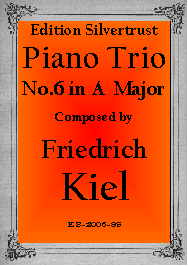Presents
Friedrich Kiel
Piano Trio No.6 in A Major, Op.65 No.1
 "The
two Op.65 piano trios are very fine works." So wrote Wilhelm Altmann,
perhaps the greatest of chamber music critics. Altmann felt that it was Kiel’s extreme modesty which
kept him and his exceptional works from receiving the consideration they
deserved. And what consideration did they deserve? After
mentioning Brahms and others, Altmann writes, “He produced a number of chamber
works, which...need fear no comparison.”
"The
two Op.65 piano trios are very fine works." So wrote Wilhelm Altmann,
perhaps the greatest of chamber music critics. Altmann felt that it was Kiel’s extreme modesty which
kept him and his exceptional works from receiving the consideration they
deserved. And what consideration did they deserve? After
mentioning Brahms and others, Altmann writes, “He produced a number of chamber
works, which...need fear no comparison.”
Kiel (1821-1885) was taught the rudiments of music and received his first piano lessons from his father but was in large part self-taught. Something of a prodigy, he played the piano almost without instruction at the age of six, and by his thirteenth year he had composed much music. Kiel eventually came to the attention of Prince Wittgenstein, a great music lover. Through the Prince's efforts, Kiel was allowed to study violin with the concertmaster of the Prince’s fine orchestra with which he later performed as a soloist. Kiel was also given theory lessons from the renowned flautist Kaspar Kummer. By 1840, the eighteen year old Kiel was court conductor and the music teacher to the prince’s children. Two years later, Spohr heard him and arranged for a scholarship which allowed Kiel to study in Berlin with the renowned theorist and teacher Siefried Dehn. In Berlin, Kiel eventually became sought after as an instructor. In 1866, he received a teaching position at the prestigious Stern Conservatory, where he taught composition and was elevated to a professorship three years later. In 1870 he joined the faculty of the newly founded Hochschule für Musik which was shortly thereafter considered one of the finest music schools in Germany. Among his many students were Noskowski, Paderewski and Stanford. Kiel's hobby was mountaineering and at age 60--two years before his tragic death as the result of a traffic accident--he climbed Europe's second highest peak, Monte Rosa.
Piano Trio No.6 dates from around 1875. Altmann, writing in more detail, describes the trio as follows:
The first movement, Allegro con passione, opens with a lovely melody sung by the cello. This theme is closely associated with more a rhythmic second subject. Next comes an Intermezzo which is full of humor and sounds quite well in spite of its contrapuntal ingenuity. The lovely third movement, Largo con espressione, is relatively short and opens with an expressive recitative. It leads straight into the finale, Vivace, which may described as kind of a Schubertian hunting piece with an especially ingratiating second theme.
It is a travesty that this work is not in the repertoire and has been out of print for more than a century. We have reprinted the first edition but corrected several serious errors and have added rehearsal numbers. Hopefully this trio will find a place in the hearts of both professionals and amateurs.
Parts: $29.95